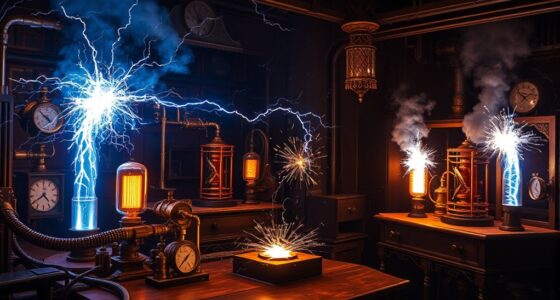Yes, a steampunk computer can exist by blending Victorian craftsmanship with modern tech. You can imagine intricate gears, brass components, and ornate dials functioning as interfaces or even logic elements. Mechanical controls like levers and gears could replace digital screens and keyboards. While fully mechanical AI systems are challenging, hybrid setups blending vintage aesthetics with hidden electronics are feasible. Curious about how these elements come together? Keep exploring to uncover how history and innovation can combine seamlessly.
Key Takeaways
- A steampunk computer can physically exist by integrating mechanical components with modern electronics within Victorian-style design.
- Mechanical gears and levers could serve as input/output controls, enhancing tactile interaction and aesthetic authenticity.
- Hybrid systems combining ornate casings with concealed digital circuitry enable functional AI integration in a steampunk style.
- Fully mechanical AI systems are impractical due to complexity, but partial mechanical logic and control mechanisms are feasible.
- Creative engineering allows blending vintage craftsmanship with modern technology, making a steampunk-inspired computer both aesthetically and functionally possible.

Steampunk computers are a fascinating blend of vintage aesthetics and modern technology that captivate enthusiasts worldwide. Imagine a machine that combines the intricate beauty of Victorian-era design with the capabilities of contemporary computing. You might picture brass gears, polished wood panels, and ornate dials, all housing advanced components that perform complex tasks. While this fusion may seem purely artistic, the question arises: could a true steampunk computer exist? To explore this, you need to understand the core elements that define modern computers, particularly artificial intelligence and mechanical interfaces.
Artificial intelligence (AI) forms the backbone of modern computation, enabling machines to learn, adapt, and perform tasks that once required human intelligence. For a steampunk computer to exist, AI would need to be integrated seamlessly into its vintage design, which is no small feat. Traditional AI relies heavily on digital circuitry—silicon chips, transistors, and microprocessors—crafted for efficiency and speed. Embedding such components into a steampunk aesthetic would demand creative engineering, perhaps hiding modern chips behind ornate casings or designing mechanical alternatives that mimic digital logic. Mechanical interfaces could serve as the physical means for users to interact with the machine, replacing or augmenting touchscreens or keyboards with levers, gears, and rotating dials. These interfaces would not only look authentic but could also offer tactile feedback, making the experience more immersive.
Integrating AI into a steampunk design demands creative engineering and mechanical interfaces for authentic, tactile interaction.
Creating a truly functional steampunk computer involves more than just aesthetics. You’d need to develop mechanical equivalents of electronic components—geared processors, mechanical memory, and analog circuits—that can perform logical operations. While these are conceptually possible, they tend to be bulky, slower, and less reliable than their electronic counterparts. Nonetheless, innovative enthusiasts could design hybrid systems that combine mechanical interfaces with miniaturized electronic parts concealed within vintage exteriors. This would allow the machine to process data and run AI algorithms while maintaining a steampunk appearance.
The feasibility of such a device hinges on bridging the gap between Victorian craftsmanship and modern engineering. It’s not just about aesthetics but creating a functional system that can handle AI-driven tasks. Mechanical interfaces could be designed to control and configure the system, making it a tactile experience rather than a digital one. While a fully mechanical AI-powered computer remains a challenge, partial implementations—like mechanical control panels for digital computers—prove that blending old-world charm with cutting-edge tech is possible. Ultimately, a steampunk computer isn’t just a fantasy; with enough ingenuity, it could become a reality that marries history with innovation.
Frequently Asked Questions
Could Steampunk Computers Operate With Modern Software?
Yes, steampunk computers could operate with modern software, but you’d need to adapt the antique aesthetics and mechanical interfaces. These machines would require custom hardware that mimics vintage design while supporting contemporary coding and data processing. You’d likely develop specialized software interfaces that translate digital commands into mechanical actions, blending old-fashioned charm with new technology, creating a unique fusion of the past and present in your steampunk-inspired device.
What Materials Would Be Used in a Steampunk Computer?
You’d use a dazzling mix of Victorian aesthetics and brass components, of course. Imagine gears, cogs, and pipes galore—each piece shining like a treasure from a bygone era. Copper wiring, leather accents, and glass panels would complete the look, making your steampunk computer both functional and fantastically ornate. It’s a lovely dance of Victorian style and steampunk whimsy, turning technology into a steampunk masterpiece that’s as eye-catching as it is quirky.
How Would a Steampunk Computer Handle Data Storage?
A steampunk computer would handle data storage using steam-powered memory and brass data tapes. You’d load information onto the brass tapes, which would then be fed into the machine, powered by steam engines. The steam-driven memory would temporarily hold data, allowing you to process and retrieve information. This vintage approach combines mechanical ingenuity and aesthetic charm, creating a unique, steampunk-inspired data storage system that’s both functional and visually mesmerizing.
Are There Any Existing Steampunk Computer Prototypes?
No, there aren’t any real steampunk computer prototypes, but you can find many artistic creations inspired by Victorian aesthetics and mechanical innovation. Enthusiasts often build steampunk-inspired devices that mimic computers using gears, brass, and vintage-looking components. These prototypes emphasize craftsmanship and design over functionality, offering a nostalgic glimpse into a Victorian-inspired world where mechanical innovation fuels futuristic technology.
Would Steampunk Designs Affect Computer Performance?
Steampunk designs would likely impact computer performance due to aesthetic implications and manufacturing challenges. The intricate, vintage-inspired details might make cooling and component access harder, potentially reducing efficiency. Plus, sourcing authentic materials or custom parts could increase complexity and cost. While visually stunning, these aesthetic choices could introduce constraints that hinder peak performance, making it a trade-off between style and functionality in your steampunk-inspired computer.
Conclusion
So, while a true steampunk computer might be a fantastical dream, imagining its gears and cogs reminds you that innovation often rises from the depths of imagination. Like a clockwork universe, it’s a reminder that technology isn’t just cold metal—it’s a canvas for stories, dreams, and endless curiosity. Embrace the steampunk spirit: where the past’s artistry fuels the future’s wildest possibilities, turning machinery into a symphony of human ingenuity.









